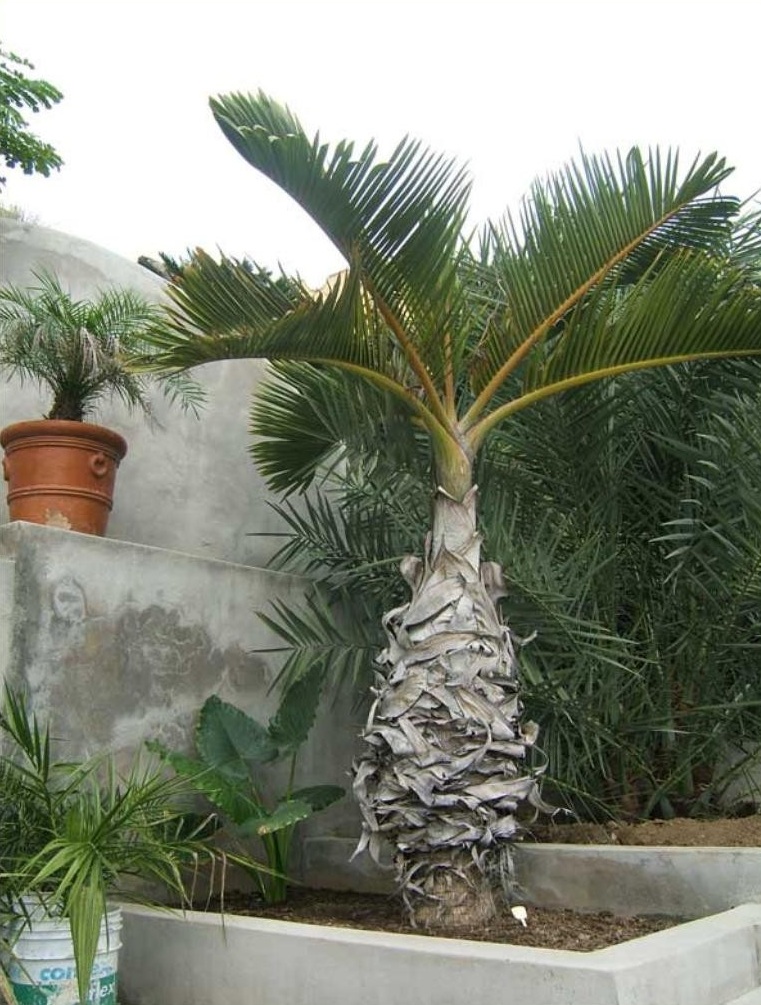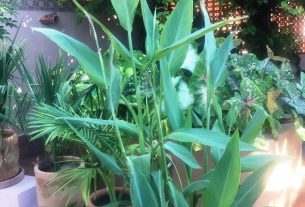By Tommy Clarkson from the September 2010 Edition
Hyophorbe lagenicaulis
Family: Arecaceae; Subfamily: Ceroxyloideae
Genus: Hyophorbe; Species: lagenicaulis
With a unique, bulge shaped, 360 degree pot-bellied, ring scarred, grey trunk, this smallish, slow growing, palm just seems to make most folks smile. And, if one is limited in yard space, this happy, little palm can still provide an attractive tropical look.
Enjoying full sun to partial shade, it is one of five species of similar palms originally found on tiny Round Island of the Mascarene Islands, east of Madagascar, but is now, virtually, at the point of extinction in its natural habitat.

Not a large palm, fully grown they are in the four to six meter range. While young, they look quite nice on the patio or even indoors (with lots of sunshine) in a pot.
Quite the opposite of my own torso, as the Bottle Palm matures its trunk begins to elongate and flatten. Family-wise, the striking Spindle Palm is its non-swollen trunked cousin.
Atop the Bottle Palm’s unique trunk is its smooth, green to grey/blue-green and waxy crownshaft. Above that, proudly and rather perkily, sets a beautiful (one authority calls them “dramatically architectural”) crown of four to eight stiff, rich green, pinnate, (featherlike) fronds.
Though few in number, these upwardly arching leaves are very eye-catching and can grow to be over three meters in length in the older specimens. The approximately 140, two feet long, upward pointing leaflets, are arranged at a 45 degree angle in a V shape of two upward pointing rows.
For me, the way the old palm frond “stubs’ wrap around the bottle part of the trunk is a great deal of the attractiveness and charm of this delightful, gnome-like character.
The flowering part of the plant (inflorescences) may be found at the point where the crownshaft meets the trunk. These small, creamy white flowers both male and female can be found on the same stalk. The small, one inch, round, berry-like, fruits that, logically, come from the females, transform their color from green to black.
As long as it is well drained, the Bottle palm does well in many types of soil and is quite salt tolerant – hence a good choice for plating on the seashore. Having so said, they are no different than us, to stay good and healthy they prefer quarterly (fertilizer) meals and regular, deep, watering particularly during the dry season.
Clearly a warm weather palm, the Bottle Palm does not like freezing temps, frost or any manner of cold. (Patty and I can well relate to that!) They can be presented as a stand alone, solitary specimen or, if space allows, perhaps as a multi-sized threesome. Either way they are a delightful addition to anyone’s home.
Download the full edition or view it online
—
Tommy Clarkson is a bit of a renaissance man. He’s lived and worked in locales as disparate as the 1.2 square mile island of Kwajalein to war-torn Iraq, from aboard he and Patty’s boat berthed out of Sea Bright, NJ to Thailand, Germany, Hawaii and Viet Nam; He’s taught classes and courses on creative writing and mass communications from the elementary grades to graduate level; He’s spoken to a wide array of meetings, conferences and assemblages on topics as varied as Buddhism, strategic marketing and tropical plants; In the latter category he and Patty’s recently book, “The Civilized Jungle” – written for the lay gardener – has been heralded as “the best tropical plant book in the last ten years”; And, according to Trip Advisor, their spectacular tropical creation – Ola Brisa Gardens – is the “Number One Tour destination in Manzanillo”.




You must be logged in to post a comment.